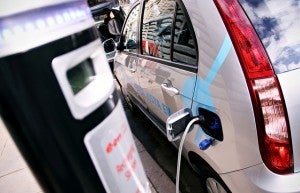In California, Electric Vehicles are the New DeLorean in ‘Back to the Future’
 As any child of the ’80s knows, October 21, 2015 is “Back to the Future Day” – the day that the film’s protagonist, Marty McFly, travels to the future in his DeLorean. Though it would no doubt be useful to have access to flying cars (think of the traffic one could avoid), Californians are seeing increased access to something more practical: electric vehicles (EVs).
As any child of the ’80s knows, October 21, 2015 is “Back to the Future Day” – the day that the film’s protagonist, Marty McFly, travels to the future in his DeLorean. Though it would no doubt be useful to have access to flying cars (think of the traffic one could avoid), Californians are seeing increased access to something more practical: electric vehicles (EVs).
In order to meet the state’s greenhouse gas (GHG) reduction goals, emissions from transportation – the sector most responsible for harmful pollution – need to be addressed. Enter Governor Brown’s zero-emission vehicle (ZEV) mandate, which aims to build enough infrastructure statewide to support one million clean vehicles by 2020, and put 1.5 million ZEVs on the road by 2025. With this executive order, we have a much better chance of ensuring a low-carbon future and effectively combatting climate change in California.
If we build it, they will come
To have a decent shot at meeting the governor’s goals, the state needs to start with charging infrastructure. Despite evolving battery technology, range anxiety is still one of the top deterrents for would-be EV buyers. So, putting more charging stations where drivers are likely to need them will help grow the market for these clean vehicles.
Thankfully, the California Public Utilities Commission (CPUC) issued two proposed decisions on Dec. 15 and Dec. 23, giving Southern California Edison (SCE) and San Diego Gas and Electric (SDG&E) the opportunity to move forward with plans to increase charging infrastructure in their respective service territories. These decisions include modifications to the utilities’ original proposals – and SDG&E must still decide whether or not to accept the Commission’s modifications – but they nevertheless represent an important step in the journey to getting more EVs on the road.
[Tweet “In CA, #ElectricVehicles are the new DeLorean in ‘Back to the Future'”]
Importantly, under these programs, SDG&E and SCE propose to grow the electric vehicles market in an intelligent way, by focusing on the following areas:
- Charging stations at multi-unit dwellings and workplaces. Currently underserved in terms of charging infrastructure, it makes good sense for the utilities to focus on these areas. In addition, making workplaces a focal point helps to ensure EVs are charging at times when there is an abundance of solar on the electric grid (typically between the hours of 11 AM – 3 PM, when solar panels are most productive).
- EVs as grid-balancing resources. Both SDG&E and SCE offer provisions in their programs that endeavor to discourage EV owners from charging at times of “peak,” or high energy demand, instead encouraging them to charge when renewable energy is plentiful. Of particular note, SDG&E includes a dynamic electricity tariff that, with the addition of a smartphone app, gives drivers an easy way to identify the cheapest – and most grid-beneficial – times to charge.
- Disadvantaged communities. Both SDG&E and SCE specifically set aside a percentage of charging stations for disadvantaged communities. In doing so, they are including a key demographic that is all too often overlooked. By helping increase the reach of EVs in communities that consistently suffer disproportionate impacts from pollution, the utilities can ensure the benefits of EVs have a much broader reach than they otherwise might.
More EVs mean more benefits for California
More charging infrastructure will lead to a bigger EV market, which will in turn lead to cleaner transportation for many Californians. More specifically, broader EV adoption can do the following, if these vehicles are deployed properly:
- Cut down on greenhouse gas emissions. Because EVs, unlike their fossil-fueled counterparts, do not produce combustion emissions, they can significantly cut down on harmful pollution. That being said, it is also critical to know how the electricity powering these cars is produced. Charging at times when there is an abundance of solar or wind available means EVs are powered by clean energy resources, and not by fossil fuel power plants.
- Store renewable energy. Cars that charge in the middle of the day or late at night can store renewable energy. Therefore, even if people don’t use this clean power immediately, they can draw on it when the sun sets or the wind isn’t blowing. In this way, Californians avoid the need to rely on natural gas power plants that are often deployed at peak times – namely, in the early evening hours.
- Enhance electric grid reliability. In order for the electrical grid to be stable, supply has to roughly equal demand. However, there are times when there is an over-generation of solar, which leads to a surplus of supply relative to demand. This creates the potential for reliability concerns, as well as the possibility of fossil fuel power plants to quickly ramp up electricity production. By acting as a storage device in times of renewable over-generation, EVs can soak up excess renewable energy and head off these concerns.
EDF is excited that the Commission has left the door open for SDG&E and SCE to move forward with modified versions of these critical and well-thought-out programs. This green light will go a long way towards building a more sustainable and cleaner California. Now if only Tesla would help fulfill the fantasy of Millennials everywhere and come out with that flying car.
Photo source: Flickr/Birmingham News Room
This post originally appeared on our California Dream 2.0 blog.










